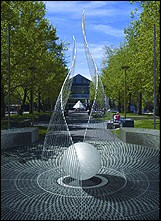Dangerous Seas
contributed by Michael Hall
|
The discovery of the wreck of the World War 2 hospital ship Centaur in 2009 highlights the danger of traversing the seas in times of war. It was not always the enemy who provided the risk. Before World War 1 Joseph Perry worked as a groom at the Royal Military College, Duntroon. He was a British Army Imperial Reservist, having served with the 3rd Battalion, Manchester Regiment for many years and, when war was declared in August 1914, he was among the first to be called up. Perry was on leave in Ireland in November 1916 when the ship he was on, the S.S. Connemarra, sank at the entrance to Carlingford Lough after colliding with another vessel. He drowned, though others were more fortunate. Douglas Cavaye was aboard the transport ship HMAT Ballarat when it was torpedoed by a German U-boat in the English Channel in 1917. All aboard were rescued, as was Sr. Patricia Blundell when her ship, the Barunga was sunk in the Bay of Biscay in July 1918. Sadly for grieving relatives in Australia, the Barunga was also carrying the personal belongings of men killed in the war. Surviving the sinking of your ship was no guarantee of survival, even for a woman. Mona Tait arrived in Canberra in 1937 to work as a nursing sister at Canberra Hospital. After enlisting in the Australian Army Nursing Corps she was sent to the 2/13 Australian General Hospital in Singapore. Sr. Tait was among the last 65 Australian nurses evacuated from Singapore on 12 February 1942 just before the garrison surrendered to the Japanese; however her ship, the S.S. Vyner Brooke, was sunk by the Japanese off the coast of Banka Island a few days later. Amongst the survivors who gathered on Radji Beach was Sr. Tait. When Japanese soldiers arrived they bayoneted the men and forced the 22 Australian nurses to wade into the sea where they were shot from behind. Only one nurse, Vivian Bullwinkel, survived. Mona Tait did not. The Reverend Vivian Thompson was the Methodist minister in Canberra before he enlisted for service in World War 1. He served as a chaplain with the Royal Australian Navy for more than 25 years and was aboard the HMAS Sydney when it sank the Bartelomeo Colleoni in the Mediterranean Sea in July 1940. Shortly after though, he was transferred to shore. His years at sea had taken its toll as the captain of the Sydney reported; “he is old for his years (he was 56) and this fact combined with a frail constitution has been a handicap to him in the exacting condition of a cruiser in war”. When the Sydney was sunk during a battle with the German raider Kormoran off the coast of Western Australia eleven months later the effect on Reverend Thompson must have been devastating as he had served as a spiritual leader for almost three years to the Sydney’s men. He died a year later. The single greatest maritime disaster in World War 2 involving Australians occurred on 1 July 1942 with the sinking of the Japanese transport the Montevideo Maru. This ship was carrying prisoners from Rabaul to Hainan Island in the South China Sea. Aboard were 852 Australian POWs and 208 civilian internees who had been imprisoned when the Japanese captured Rabaul. Amongst the men were Reg Curtis, Norman Gair, Alan Starkey and James Walker. All were killed when a US submarine, unaware that the unmarked Montevideo Maru was carrying prisoners, torpedoed the ship off the Philippines. The greatest risk was to the sailors who operated the ships. George Drayton was on HMAS Nestor when it was bombed by Germans in June 1942 and scuttled off the coast of Crete. Charlie Jackson was a sailor on HMAS Perth when she battled several Japanese ships in the Sunda Strait of Indonesia in 1942. The Perth was sunk and Jackson was one of more than 350 men who died. Les Hart served on HMAS Australia when she was subjected to repeated kamikaze attacks by Japanese pilots. He was killed during one of the attacks on 5 January 1945. Nor did Australian waters guarantee safety. Raymond Venning enlisted in the navy in 1941 and completed training as an Ordinary Seaman at Garden Island in Sydney. While he was waiting for a posting to a ship he was accommodated on an old ferry, the Kuttabul. On the night of 31 May 1942 three Japanese midget submarines tried to enter Sydney Harbour. One of the subs managed to fire two torpedoes at the USS Chicago berthed near Garden Island and though the torpedoes missed the American heavy cruiser, one struck the sea wall. The explosion sank the nearby Kuttabul killing twenty one sailors, including Venning. Percy Kelly was aboard the Centaur when she was torpedoed by a Japanese submarine on 14 May 1943 off the coast of Queensland killing more than 260 people. The 64 survivors spent more than a day in the sea before they were rescued. Fortunately for Kelly he was one of them. |
 |

